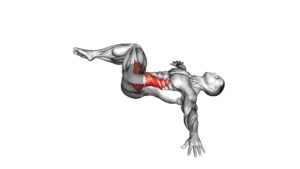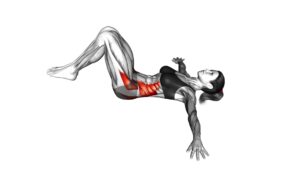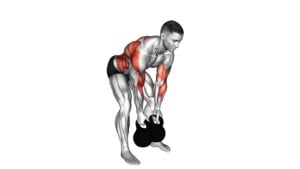Bent Over Twist – Video Exercise Guide & Tips

Are you looking for a new exercise to add to your routine?
Watch This Exercise Video
Look no further than the Bent Over Twist.
This video exercise guide will show you the proper form and technique, along with modifications for different fitness levels.
Avoid common mistakes and get the most out of this exercise with helpful tips.
Don't forget to prioritize safety by following the provided precautions and considerations.
Get ready to twist your way to a stronger body!
Key Takeaways
- The Bent Over Twist exercise improves flexibility, strengthens the core, enhances spinal mobility, and increases rotational strength.
- Proper form and technique are crucial for this exercise, including engaging the core, focusing on breathing and controlled exhales, maintaining stability and preventing strain on the lower back, and hinging at the hips while keeping the back straight.
- Core engagement is important as it provides stability, generates power and strength, prevents injuries, improves performance, and offers functional benefits.
- To avoid lower back strain during the Bent Over Twist, it is essential to maintain proper form and technique, stand with feet hip-width apart, engage core muscles, hinge at the hips while keeping the back straight, and rotate the torso without overtwisting or jerking.
Benefits of the Bent Over Twist
Discover the benefits of the Bent Over Twist for improving flexibility and strengthening your core. This exercise is highly effective in enhancing spinal mobility and increasing rotational strength. By incorporating the Bent Over Twist into your workout routine, you can experience improved flexibility and a stronger core.
One of the key benefits of the Bent Over Twist is its ability to enhance spinal mobility. As you perform the exercise, you engage the muscles in your back, including the erector spinae, which are responsible for extending and rotating the spine. This movement helps to increase the range of motion in your spine, allowing for improved flexibility and ease of movement.
Additionally, the Bent Over Twist is a great exercise for increasing rotational strength. As you twist your torso from side to side, you activate the obliques, which are responsible for rotational movements. By regularly incorporating this exercise into your routine, you can develop stronger oblique muscles, leading to increased rotational strength and stability in your core.
Proper Form and Technique
To perform the Bent Over Twist with proper form and technique, it's crucial to engage your core throughout the exercise. This will help stabilize your body and prevent strain on your lower back.
Additionally, focusing on your breathing and using controlled exhales can further enhance stability and ensure proper execution of the movement.
Core Engagement Importance
Why is core engagement important when performing the Bent Over Twist exercise?
Core activation and muscle engagement during the Bent Over Twist exercise are essential for several reasons:
- Stability: Engaging your core helps stabilize your body, allowing you to maintain proper form and balance throughout the exercise.
- Power generation: A strong core provides a solid foundation for generating power and strength during the twist movement.
- Injury prevention: By activating your core, you protect your spine and surrounding muscles, reducing the risk of injury.
- Improved performance: Engaging your core enhances your overall performance, allowing you to generate more force and control your movements efficiently.
- Functional benefits: Strong core muscles contribute to better posture, everyday movements, and overall body stability, improving your daily activities and reducing the risk of strains or imbalances.
Remember to focus on activating your core and maintaining proper form to get the most out of the Bent Over Twist exercise.
Avoiding Lower Back Strain
Maintain proper form and technique to avoid lower back strain during the Bent Over Twist exercise. Preventing back pain is crucial to ensure a safe and effective workout.
To protect your lower back, start by standing with your feet hip-width apart and engage your core muscles. As you bend forward, hinge at your hips while keeping your back straight and your gaze forward. Avoid rounding your back or arching excessively.
To strengthen your obliques, rotate your torso to one side while keeping your hips stable. Be mindful of not overtwisting or jerking your body.
Remember to breathe throughout the exercise, inhaling as you rotate and exhaling as you return to the starting position.
Breathing Techniques for Stability
Engage your core muscles and focus on your breath to maintain stability during the Bent Over Twist exercise. Proper breathing techniques can help you stay balanced and prevent injury. Here are some tips to help you achieve stability through deep breathing and diaphragmatic breathing:
- Take slow, deep breaths in through your nose, filling your belly with air.
- Exhale slowly through your mouth, fully emptying your lungs.
Coordinate your breath with the movement of the exercise, inhaling as you twist to one side and exhaling as you return to the starting position.
Keep your breath steady and controlled throughout the entire exercise.
Use your breath to create a sense of stability and control in your core, allowing you to maintain proper form and technique.
Modifications for Different Fitness Levels
To modify the Bent Over Twist exercise for different fitness levels, adjust the intensity by varying the weight or resistance used. Fitness modifications are important to ensure that you're challenging yourself appropriately and avoiding injury.
If you're a beginner, start with a lighter weight or resistance band to get used to the movement and build strength gradually. As you become more comfortable and stronger, you can gradually increase the weight or resistance to continue challenging yourself.
For those at an intermediate level, you can use a moderate weight or resistance band to perform the Bent Over Twist. This will provide a good level of challenge without being too overwhelming. Remember to maintain proper form and engage your core throughout the exercise.
Advanced fitness levels can increase the intensity of the Bent Over Twist by using heavier weights or resistance bands. This will require more strength and stability, challenging your muscles even further. Make sure to listen to your body and only increase the weight or resistance if you can maintain proper form and control.
By adjusting the weight or resistance used in the Bent Over Twist exercise, you can tailor it to your individual fitness level and goals. This will help you progress and continue to challenge yourself as you become stronger and more experienced.
Now that you understand how to modify the Bent Over Twist for different fitness levels, let's explore some common mistakes to avoid.
Common Mistakes to Avoid
To ensure proper form and maximize the effectiveness of the Bent Over Twist exercise, it's important to be aware of common mistakes to avoid. Here are some tips for improvement:
- Rounding your back: One common mistake is rounding your back during the exercise. This can put unnecessary strain on your spine and reduce the effectiveness of the twist. Instead, focus on keeping your back straight and engaged throughout the movement.
- Using momentum: Another mistake is relying on momentum to twist your body. This takes away from the targeted muscles and reduces the overall effectiveness of the exercise. Instead, engage your core and use controlled movements to twist from side to side.
- Neglecting proper breathing: Many people forget to breathe properly during the Bent Over Twist. It's important to inhale deeply as you twist to one side and exhale as you return to the starting position. This will help you maintain proper form and engage your core effectively.
- Not engaging your core: Failing to engage your core can lead to a lack of stability and can diminish the benefits of the exercise. Make sure to actively contract your abdominal muscles throughout the entire movement.
- Over-twisting: Over-twisting can strain your back and neck muscles. It's important to twist only as far as you comfortably can without compromising your form.
Tips for Getting the Most Out of the Exercise
To get the most out of the Bent Over Twist exercise, it's important to focus on proper form techniques.
Keep your back straight, engage your core, and maintain a slight bend in your knees.
Additionally, pay attention to your breathing. Inhale deeply as you twist to one side and exhale as you return to the starting position, using your breath to stabilize and engage your core muscles.
Proper Form Techniques
You can maximize your results and prevent injury by focusing on proper form while performing the Bent Over Twist exercise. To ensure proper core activation and spinal alignment, keep the following tips in mind:
- Start by standing with your feet hip-width apart and knees slightly bent.
- Hinge forward at your hips, maintaining a neutral spine and engaging your core.
- Keep your shoulders relaxed and your gaze forward to avoid straining your neck.
- As you twist, make sure to rotate from your torso and not just your arms.
- Exhale as you twist, focusing on engaging your obliques and maintaining stability.
By following these proper form techniques, you can enhance the effectiveness of the Bent Over Twist exercise and reduce the risk of injury.
Now, let's move on to the next section and explore breathing techniques for stability.
Breathing Techniques for Stability
Maintain stability and optimize the effectiveness of the Bent Over Twist exercise by incorporating proper breathing techniques.
Breathing control plays a crucial role in enhancing stability during this exercise. As you twist your torso, exhale gradually and fully. This controlled exhalation engages your core muscles, allowing for better stability and balance.
Focus on emptying your lungs completely before inhaling again. By doing so, you activate your deep abdominal muscles, which provide stability to your spine.
Additionally, as you inhale, imagine filling your ribcage with air, expanding it in all directions. This deep breath helps to maintain a stable foundation while performing the Bent Over Twist.
Incorporating these breathing techniques will enhance your stability and overall performance during this exercise.
Safety Precautions and Considerations
Are there any specific safety precautions or considerations to keep in mind while performing the Bent Over Twist exercise? Absolutely! Ensuring your safety and preventing injuries should always be a top priority when engaging in any exercise routine. Here are some important safety measures and injury prevention tips to keep in mind while performing the Bent Over Twist:
- Warm up: Before starting the exercise, it's crucial to warm up your body to increase blood flow, flexibility, and prepare your muscles for the activity.
- Maintain proper form: Focus on maintaining a straight back throughout the exercise to avoid straining your spine or putting unnecessary pressure on your lower back.
- Start with lighter weights: If you're using weights for this exercise, begin with lighter weights and gradually increase the load as your strength improves to prevent overexertion.
- Listen to your body: Pay attention to any discomfort or pain. If you experience any sharp pain or discomfort, stop immediately and consult a healthcare professional.
- Modify as needed: If you have any pre-existing injuries or conditions that may be aggravated by this exercise, consider modifying the movement or seeking guidance from a fitness professional.
Frequently Asked Questions
Can the Bent Over Twist Exercise Help With Improving Flexibility?
The bent over twist exercise can be a great way for you to improve flexibility. By incorporating rotational movements, this exercise helps to increase mobility in your back, hips, and shoulders.
Rotational exercises like the bent over twist have numerous benefits, including improving range of motion and reducing stiffness in the spine.
Adding this exercise to your routine can contribute to overall flexibility and enhance your ability to perform daily activities with ease.
How Many Sets and Reps Should Be Performed for the Bent Over Twist Exercise?
To perform the bent over twist exercise properly and achieve results, it's important to consider the number of sets and reps.
The recommended approach is to start with 2-3 sets of 10-12 reps. This will help you build strength and improve flexibility in your core and back muscles.
Remember to maintain proper form and technique throughout the exercise to maximize its benefits.
Can the Bent Over Twist Exercise Be Beneficial for People With Lower Back Pain?
The bent over twist exercise can be beneficial for people with lower back pain. By engaging the core and stretching the spine, it can help strengthen the muscles that support the lower back.
However, it's important to modify the exercise to avoid aggravating the pain. Start with a smaller range of motion and listen to your body. If any discomfort arises, stop and consult with a healthcare professional for further guidance.
Is It Necessary to Warm up Before Performing the Bent Over Twist Exercise?
Before performing the bent over twist exercise, it's necessary to warm up your body. Dynamic warm up exercises have several benefits, such as increasing blood flow to your muscles and improving flexibility. They prepare your body for the workout ahead and reduce the risk of injury.
If you're looking for alternative exercises to target your obliques and core muscles, there are plenty of options available. Some examples include side planks, Russian twists, and bicycle crunches.
Can the Bent Over Twist Exercise Be Incorporated Into a Full-Body Workout Routine?
Yes, the bent over twist exercise can definitely be incorporated into a full-body workout routine. It's a great exercise for improving core strength and stability.
There are also variations of the bent over twist exercise that you can try to target different muscle groups and add variety to your workout.
Incorporating this exercise into your routine will help you achieve a well-rounded and effective full-body workout.
Conclusion
In conclusion, the bent over twist is a highly effective exercise that offers numerous benefits. These benefits include improved core strength, increased flexibility, and better posture.
To perform this exercise correctly, it's important to maintain proper form and technique. This includes keeping a straight back, engaging the core muscles, and using controlled movements. It's also important to consider modifications for different fitness levels. Beginners may need to start with lighter weights or perform the exercise without weights until they build up strength and stability.
Avoiding common mistakes is also crucial to getting the most out of this exercise. These mistakes include rounding the back, using momentum to twist, and not engaging the core muscles properly. By being mindful of these errors and focusing on proper form, individuals can maximize the benefits of the bent over twist.
Lastly, always prioritize safety when performing any exercise. This includes taking necessary precautions such as warming up before starting the exercise, using proper equipment, and listening to your body. It's also important to consider any individual limitations or conditions that may affect your ability to perform the exercise safely. If you have any concerns, consult with a healthcare professional or certified fitness instructor.

Author
Years ago, the spark of my life’s passion ignited in my mind the moment I stepped into the local gym for the first time. The inaugural bead of perspiration, the initial endeavor, the very first surge of endorphins, and a sense of pride that washed over me post-workout marked the beginning of my deep-seated interest in strength sports, fitness, and sports nutrition. This very curiosity blossomed rapidly into a profound fascination, propelling me to earn a Master’s degree in Physical Education from the Academy of Physical Education in Krakow, followed by a Sports Manager diploma from the Jagiellonian University. My journey of growth led me to gain more specialized qualifications, such as being a certified personal trainer with a focus on sports dietetics, a lifeguard, and an instructor for wellness and corrective gymnastics. Theoretical knowledge paired seamlessly with practical experience, reinforcing my belief that the transformation of individuals under my guidance was also a reflection of my personal growth. This belief holds true even today. Each day, I strive to push the boundaries and explore new realms. These realms gently elevate me to greater heights. The unique combination of passion for my field and the continuous quest for growth fuels my drive to break new ground.







